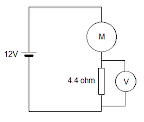I tried to use a shunt to measure the current draw of a drill motor to prevent the multimeter from exploding but ended up with it supposedly drawing 16A continuously and about an 1A on start up which seems very backwards.
I've checked my wiring and my maths which are both fine but the numbers both seem very low.
Anyone got a clue as to what on earth is going on?
Shunts
Moderators: BeligerAnt, petec, administrator
Shunts
Team Imperial - What is that, metric?
- peterwaller
- Posts: 3213
- Joined: Fri Feb 15, 2002 12:00 am
- Location: Aylesbury Bucks
- Contact:
Re: Shunts
Perhaps if you show us the circuit we could analyse it for you but I have never seen a motor that draws more current when its running than when it is starting.
Re: Shunts

Having measured the resistance of the motor with a multimeter to be ~8 ohms (probably inaccurate due to it being an inductor and resistor) might mean that a larger proportion of the voltage is being drawn across the shunt resistor. I'll try using a length of wire as my shunt to drop the resistance considerably and hope it works.
Team Imperial - What is that, metric?
-
Andrew_Hibberd
- Posts: 1134
- Joined: Tue Jan 20, 2004 12:00 am
- Location: London
- Contact:
Re: Shunts
What are you using as your voltage source for your test? Also could you post your results of what voltages you are reading
TEAM GEEK!
Re: Shunts
I'm using the 12V battery that came with the drill but I checked the resistor that I originally used and it turns out that I'd blown it at some point.
Tried again with another resistor of the same value and ended up with these results before that resistor blew up
6.39V start up => 1.45A
0.45V continuous => 0.10A
14.77V stalled => 3.37A
They all seem low but are at least the right way round.
Tried again with another resistor of the same value and ended up with these results before that resistor blew up
6.39V start up => 1.45A
0.45V continuous => 0.10A
14.77V stalled => 3.37A
They all seem low but are at least the right way round.
Team Imperial - What is that, metric?
- peterwaller
- Posts: 3213
- Joined: Fri Feb 15, 2002 12:00 am
- Location: Aylesbury Bucks
- Contact:
Re: Shunts
Having such a high value resistor will reduce the current by about 66% if the motor is 8 ohms.
You need a resistor of say 0.5 ohms to get a reasonable measurment without effecting the currnet drawn too much.
You need a resistor of say 0.5 ohms to get a reasonable measurment without effecting the currnet drawn too much.
Re: Shunts
Well I need to buy some 0.1 ohm resistors for my current limiting circuit to stop speedos from breaking so I can test it with those.
Thanks for the help everyone.
Thanks for the help everyone.
Team Imperial - What is that, metric?
- BeligerAnt
- Posts: 1872
- Joined: Wed May 15, 2002 12:00 am
- Location: Brighton
- Contact:
Re: Shunts
Since you are dropping all the battery voltage across the sense resistor (shunt) when the motor is stalled, the resistor is limiting and therefore entirely controlling the current you measure under stall conditions.
The running current doesn't seem unreasonable for a motor off-load. Remember that when the motor is doing some work it will take (significantly) more current.
As Peter says, you need a significantly lower value resistor with a much higher power rating to do this sort of measurement. I would suggest 10 of the 4.4 ohm resistors you have been using connected in parallel, to give 0.44 ohms with 10x the power handling and 1/10 of the power dissipation.
If you are using a digital meter, it is probably not fast enough to accurately show the start-up current. The worst case is the stall current.
[Edit] Check the power rating of the 0.1 ohm resistors before you blow any more up!
The running current doesn't seem unreasonable for a motor off-load. Remember that when the motor is doing some work it will take (significantly) more current.
As Peter says, you need a significantly lower value resistor with a much higher power rating to do this sort of measurement. I would suggest 10 of the 4.4 ohm resistors you have been using connected in parallel, to give 0.44 ohms with 10x the power handling and 1/10 of the power dissipation.
If you are using a digital meter, it is probably not fast enough to accurately show the start-up current. The worst case is the stall current.
[Edit] Check the power rating of the 0.1 ohm resistors before you blow any more up!
Gary, Team BeligerAnt